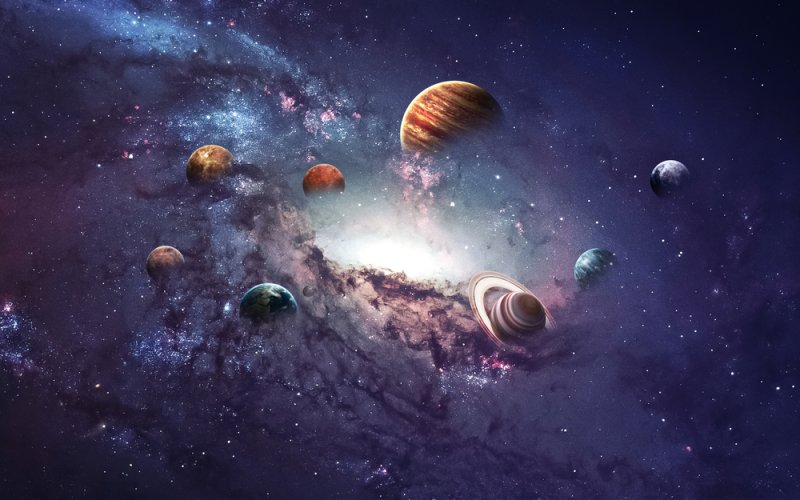In the beginning there was … well, maybe there was no beginning. Perhaps our universe has always existed – and the new theory of quantum gravity shows how this could work.
“There are so many things in reality that most people associate with science fiction or even fantasy,” Bruno Bento, a physicist who studies the nature of time at the University of Liverpool in the UK, told Live Science.
In his work, he used a new theory of quantum gravity called the theory of causal sets, in which space and time are divided into discrete parts of space-time. According to this theory, at a certain level, there is a fundamental unit of space-time.
Bento and his collaborators used this causal approach to explore the beginning of the universe. They found that it is entirely possible that the universe did not have a beginning – it always existed in the infinite past and only recently turned into what we call the Big Bang.
Quantum of gravity.
Quantum gravity is perhaps the most vexing problem in modern physics. We have two extremely effective theories of the universe: quantum physics and general relativity. Quantum physics has successfully described three of the four fundamental forces of nature (electromagnetism, weak interaction, and strong interaction) down to microscopic scales. On the other hand, general relativity is the most powerful and complete description of gravity ever invented.
But for all its strengths, general relativity is incomplete. In at least two specific places in the Universe, the mathematics of general relativity simply does not work, without giving reliable results: at the centers of black holes and at the beginning of the Universe. These areas are called “singularities,” meaning points in spacetime where our current laws of physics collapse, and they are mathematical warning signs that general relativity is tripping over itself. Within both of these singularities, gravity becomes incredibly strong at very tiny length scales.
Thus, to unravel the mysteries of the singularities, physicists need a microscopic description of strong gravity, also called the quantum theory of gravity. There are many contenders, including string theory and loop quantum gravity.
And there is another approach that completely changes our understanding of space and time.
Causal set theory
In all modern theories of physics, space and time are continuous. They form the smooth fabric underlying all reality. In such a continuous space-time, two points can be as close to each other in space as possible, and two events can occur as close to each other in time as possible.
But another approach, called causal set theory, reimagines spacetime as a series of discrete fragments or spacetime “atoms.” This theory would impose strict limits on how close events can be in space and time, since they cannot be closer than the size of an “atom.”
For example, if you look at your screen and read this, everything seems smooth and continuous. But if you look at the same screen through a magnifying glass, you can see pixels dividing the space, and you find that it is impossible to bring two images on the screen closer than one pixel.
This theory of physics excited Bento. “I was thrilled to find this theory that not only tries to become as fundamental as possible – by approaching quantum gravity and actually redefining the very notion of spacetime – but also centralizing time and what it physically means. that time will pass, how physically your past really is and whether the future already exists, ”Bento told Live Science.
The beginning of time
Causal set theory is essential to the nature of time.
“A huge part of the philosophy of causal sets is that the passage of time is something physical and cannot be attributed to some emerging illusion or to something that happens in our brain that makes us think that time is passing; this walkthrough is itself a manifestation of physical theory, ”Bento said. “So, in causal set theory, the causal set will grow one atom at a time and get bigger and bigger.”
The causal set approach neatly removes the Big Bang singularity problem, because singularities cannot exist in theory. Matter cannot be compressed to infinitely tiny points – they can be no less than the size of an atom in space-time.
So what does the beginning of our universe look like without the Big Bang singularity? It was here that Bento and his collaborator Stav Zalel, a graduate student at Imperial College London, picked up the thread by exploring what causal set theory says about the early days of the universe. Their work was published on September 24 in the arXiv preprint database. (The article has not yet been published in a peer-reviewed scientific journal.)
The article explored “whether it should have started to exist in a causal approach,” Bento said. “In the original formulation and dynamics of the causal set, classically speaking, the causal set grows out of nothing into the universe we see today. Instead, there would be no Big Bang as a beginning in our work, since the causal set would be infinite until the past, and therefore there is always something before. “
Their work implies that the universe may not have had a beginning – that it simply has always existed. What we perceive as the Big Bang could only be a special moment in the evolution of this ever-existing causal aggregate, and not the true beginning.
However, there is still a lot of work to be done. It is not yet clear if this gratuitous causal approach can allow for physical theories that we can work with to describe the complex evolution of the universe during the Big Bang.
“One can still ask if this [causal approach] can be interpreted in a ‘smart’ way, or what such dynamics physically means in a broader sense, but we have shown that structure is indeed possible,” Bento said. “So at least mathematically it can be done.”












